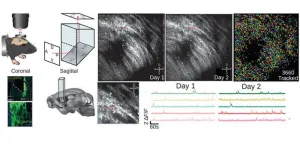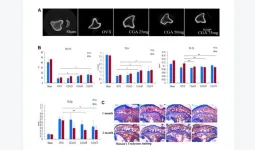(Press-News.org) TUCSON, Ariz., March 26, 2024 — Critical Path Institute (C-Path) is excited to announce the launch of the Critical Path for Alpha-1 Antitrypsin Deficiency (CPA-1) Consortium. The CPA-1 consortium aims to accelerate drug development for alpha-1 antitrypsin deficiency (AATD), a rare disease that affects individuals and families worldwide. This will be achieved by integrating data through C-Path’s Rare Diseases Cures Accelerator–Data Analytics Platform (RDCA-DAP®) and leveraging those data for CPA-1 to collaboratively develop regulatory-grade solutions to continuously address unmet needs in drug development for this condition, including:
Generating evidence to support the use and regulatory acceptance of novel drug development tools, such as biomarkers, for AATD liver and lung disease clinical trials and;
Identifying how to incorporate and utilize patients’ lived experiences to optimize clinical trial design and outcome measures that capture how patients feel, function and thrive.
Through a grant provided by the U.S. Food and Drug Administration (FDA), C-Path has engaged stakeholders in a collaborative manner, identified areas of unmet need within drug development, potential solutions, and are evaluating available data to support a regulatory grade drug development tool for novel therapies to progress in both non-clinical and clinical development for AATD.
CPA-1 brings together industry, regulatory, academic, and AATD patient groups to find solutions to progress new therapies through the drug development process. The consortium is launching two work groups to focus efforts towards AATD-associated hepatic and pulmonary disease, which in the severest stages require liver or lung transplant. Currently, treatment options are limited for those living with AATD and there is a high unmet need to address the burdens of living with AATD through drug development efforts.
Inhibrx, Takeda and global biotherapeutics leader CSL Ltd have joined as founding members of the consortium signaling the launch of this collaborative effort.
“We are proud to be a founding member of this important collaborative effort and to apply Takeda’s enduring expertise in gastroenterology to delineate a path to treatment options for people living with AATD. The burden of this rare disease is tremendous, and we are deeply committed to serving the community of patients and caregivers who for far too long have had to grapple with limited progress and innovation in the treatment landscape of this condition,” said Obi Umeh, M.D., Vice President, Franchise Global Program Leader, Rare Gastrointestinal and Inflammation Therapeutic Area Unit at Takeda.
“Our membership underscores our promise to putting our profound knowledge and extensive experience in the research of rare respiratory diseases and the development of corresponding biotherapies for those whose lives are most directly impaired by them,” said Lars Groenke, M.D., CSL’s Vice President, Co-Lead R&D Respiratory Therapeutic Area. “We are convinced that with this tangible collaborative effort, we are shaping the future path forward in accelerating the development of, and access to, new treatment options for a community where there is unmet need.”
The CPA-1 Consortium is the first C-Path effort to engage with the FDA’s Center for Biologics Evaluation and Review (CBER). Celia Witten, M.D., deputy director of CBER, has been a guiding voice supporting the establishment of CPA-1. “There is a crucial need to develop more treatments for patients with AATD,” Witten said. “There is currently no cure for this disease and no new treatments have been developed for AATD over the last three decades. This consortium will offer the opportunity for diverse stakeholders to collaborate to develop tools for clinical development to accelerate progress in this area.”
C-Path originated as an initiative to develop collaborative efforts with the FDA to address areas of unmet needs and through the years has developed a long track record of successes, particularly for rare diseases. For 20 years, C-Path has worked with the Center for Drug Evaluation and Research (CDER) to address some of the most challenging unmet needs within rare disease drug development. “We value the opportunity to once again collaborate with C-Path through the CPA-1 consortium that brings together our FDA colleagues from the hepatic and pulmonary review divisions and CBER,” noted Jeffrey Seigel, M.D., Director, Offices of Drug Evaluation Sciences (ODES).
“We are excited by the opportunity to address a critical need and work with a passionate stakeholder group within the AATD community that shares a common goal that will bring solutions and accelerate the development of novel therapies for people living with AATD. The consortium starts from a strong place with years of academic and industry data to build a solution around AATD,” commented Gina Smith, MPH, RN, C-Path Scientific Director for the CPA-1 consortium.
To learn more about C-Path’s CPA-1 consortium and its pediatric program email cpa1@c-path.org.
About Critical Path Institute
Critical Path Institute (C-Path) is an independent, nonprofit established in 2005 as a public-private partnership, in response to the FDA’s Critical Path Initiative. C-Path’s mission is to lead collaborations that advance better treatments for people worldwide. Globally recognized as a pioneer in accelerating drug development, C-Path has established numerous international consortia, programs and initiatives that currently include more than 1,600 scientists and representatives from government and regulatory agencies, academia, patient organizations, disease foundations and pharmaceutical and biotech companies. With dedicated team members located throughout the world, C-Path’s global headquarters is located in Tucson, Arizona and C-Path’s Europe subsidiary is headquartered in Amsterdam, Netherlands. For more information, visit c-path.org.
Critical Path Institute is supported by the Food and Drug Administration (FDA) of the Department of Health and Human Services (HHS) and is 54% funded by the FDA/HHS, totaling $19,436,549, and 46% funded by non-government source(s), totaling $16,373,368. The contents are those of the author(s) and do not necessarily represent the official views of, nor an endorsement by, FDA/HHS or the U.S. Government.
About CSL
CSL (ASX:CSL; USOTC:CSLLY) is a global biotechnology company with a dynamic portfolio of lifesaving medicines, including those that treat haemophilia and immune deficiencies, vaccines to prevent influenza, and therapies in iron deficiency and nephrology. Since our start in 1916, we have been driven by our promise to save lives using the latest technologies. Today, CSL – including our three businesses: CSL Behring, CSL Seqirus and CSL Vifor – provides lifesaving products to patients in more than 100 countries and employs 32,000 people. Our unique combination of commercial strength, R&D focus and operational excellence enables us to identify, develop and deliver innovations so our patients can live life to the fullest. For inspiring stories about the promise of biotechnology, visit CSL.com/Vita. For more information about CSL, visit CSL.com.
About Takeda
Takeda is focused on creating better health for people and a brighter future for the world. We aim to discover and deliver life-transforming treatments in our core therapeutic and business areas, including gastrointestinal and inflammation, rare diseases, plasma-derived therapies, oncology, neuroscience and vaccines. Together with our partners, we aim to improve the patient experience and advance a new frontier of treatment options through our dynamic and diverse pipeline. As a leading values-based, R&D-driven biopharmaceutical company headquartered in Japan, we are guided by our commitment to patients, our people and the planet. Our employees in approximately 80 countries and regions are driven by our purpose and are grounded in the values that have defined us for more than two centuries. For more information, visit www.takeda.com.
END
C-Path launches consortium for alpha-1 antitrypsin deficiency
2024-03-26
ELSE PRESS RELEASES FROM THIS DATE:
In paleontology, correct names are keys to accurate study
2024-03-26
COLUMBUS, Ohio – When the skeletal remains of a giant ground sloth were first unearthed in 1796, the discovery marked one of the earliest paleontological finds in American history.
The animal, named Megalonyx by Thomas Jefferson in 1799, was the first genus of fossil named from the United States. Thought to have roamed North America during one of the last ice ages, the extinct giant ground sloth was an herbivorous mammal resembling a large bear — at full size, it likely reached nearly 10 feet tall (3 meters) and weighed about as much as a small elephant.
The report made by Jefferson, an avid fossil collector who was known to keep ...
Imaging deep brain activity with microprisms
2024-03-26
Organisms constantly face the challenge of adapting their behavior to survive in a world full of uncertainties. This ability relies on complex neural circuits in the brain that help them find resources while avoiding danger. Scientists study how these neural circuits change over time to understand better how behaviors emerge.
One powerful way to study these changes is through optical imaging techniques that allow researchers to track the activity of individual brain cells. Traditional methods rely on observing the activity of cells directly, ...
Chlorogenic acid prevents ovariectomized-induced bone loss by facilitating osteoblast functions and suppressing osteoclast formation
2024-03-26
“[...] chlorogenic acid appears to be a promising candidate for the management of osteoporosis.”
BUFFALO, NY- March 26, 2024 – A new research paper was published in Aging (listed by MEDLINE/PubMed as "Aging (Albany NY)" and "Aging-US" by Web of Science) Volume 16, Issue 5, entitled, “Chlorogenic acid prevents ovariectomized-induced bone loss by facilitating osteoblast functions and suppressing osteoclast formation.”
Osteoporosis is a common bone disease in ...
Researchers identify protein sensor that plays a role in lung fibrosis
2024-03-26
Researchers at Weill Cornell Medicine have discovered a protein called SEL1L that plays a critical role in clearing collagen from tissue, and which may be a therapeutic target to help prevent fibrosis, scar tissue that interferes with organ function. The paper, published on Feb. 20 in Nature Communications, provides clues that could lead to drug development for diseases like lung fibrosis which have no therapeutic options currently.
Corresponding author, Dr. Michael J. Podolsky, assistant professor of medicine at Weill Cornell Medicine, has led a team that searched the human genome for genes involved in the ...
Johns Hopkins Children’s Center study shows negative impact of COVID-19 pandemic on youth minority mental health
2024-03-26
FOR IMMEDIATE RELEASE
Recent historical, political and public health events, most notably the COVID-19 pandemic, have collectively contributed to increased stress and mental health challenges among many groups of people — including adolescents in racial and ethnic minorities.
In a study published Feb. 1 in Academic Pediatrics, Johns Hopkins Children’s Center researchers investigated the pandemic’s effect on preexisting mental health disparities among youth, and found rates of depression, anxiety, and suicidal thoughts and behaviors ...
Researchers a step closer to a cure for HIV
2024-03-26
By 2030, the World Health Organization (WHO), the Global Fund and UNAIDS are hoping to end the human immunodeficiency virus (HIV) and AIDS epidemic. An international team of researchers led by Eric Arts, professor at the Schulich School of Medicine & Dentistry, and Jamie Mann, senior lecturer at the University of Bristol (U.K.), has brought us another step closer to meeting this goal, by finding an effective and affordable targeted treatment strategy for an HIV cure.
In a first, the study published ...
AI predicts the taste and quality of beer
2024-03-26
Leuven (Belgium) 26 March 2024 - Belgian scientists have developed AI models that can predict how a particular beer will be rated by consumers, and what aroma compounds brewers can add to improve it. The research was published today in the renowned scientific journal Nature Communications and may revolutionize how the food and beverage industry develops new products.
Tricky to compare
Comparing and ranking flavor profiles of different beers is a challenge. There are a multitude of guides on the market describing ...
A global map of how climate change is changing winegrowing regions
2024-03-26
Grapes grown to make wine are sensitive to climate conditions such as temperature and extreme drought. These effects are already visible worldwide on yields, the composition of grapes and the quality of wines, with already and soon-to-be-observed consequences on the geography of wine production. Understanding shifts in wine production potential due to climate change is a major scientific concern. Based on their expertise and a thorough analysis of the scientific literature — over 250 publications in the last 20 years – a research team has established a global map of evolving trends in the threats and potential benefits that climate change brings ...
SwRI’s Dr. Rohini Giles receives NASA Early Career Achievement Medal
2024-03-26
SAN ANTONIO — March 26, 2024 —Southwest Research Institute Senior Research Scientist Dr. Rohini Giles has received the NASA Early Career Achievement Medal. The medal recognizes unusual and significant performance supporting NASA’s mission during the first 10 years of their career. Giles was cited for “significant early career achievements in the analysis of Juno data to study Jovian Transient Luminous Events and the distribution of constituents in Jupiter’s atmosphere.”
“It’s ...
Sodium intake and cause-specific mortality among predominantly low-income Black and white residents
2024-03-26
About The Study: In this cohort study of 64,000 low-income Americans, nearly 80% of study participants consumed sodium exceeding the current recommended daily amount, which was associated with 10% to 30% of cardiovascular disease mortality. Public health programs targeted to reduce sodium intake among this underserved population may be beneficial.
Authors: Xiao-Ou Shu, M.D., Ph.D., of the Vanderbilt University School of Medicine in Nashville, is the corresponding author.
To access the embargoed study: Visit our For The Media website at this link https://media.jamanetwork.com/
(doi: 10.1001/jamanetworkopen.2024.3802)
Editor’s Note: Please see the ...






